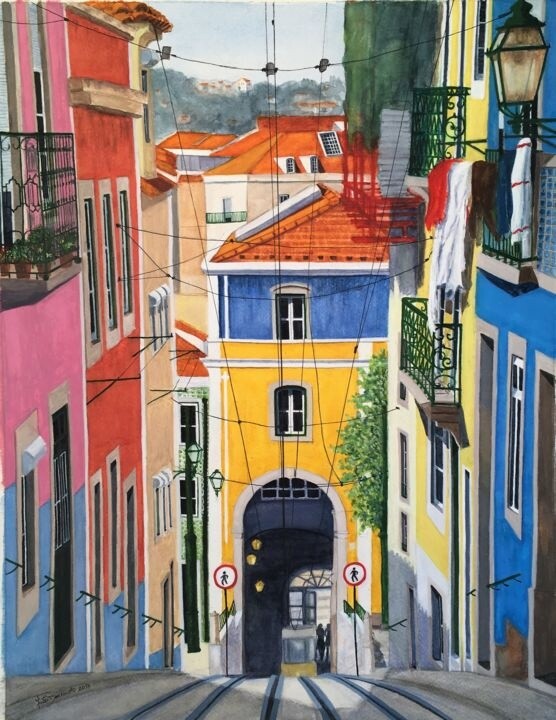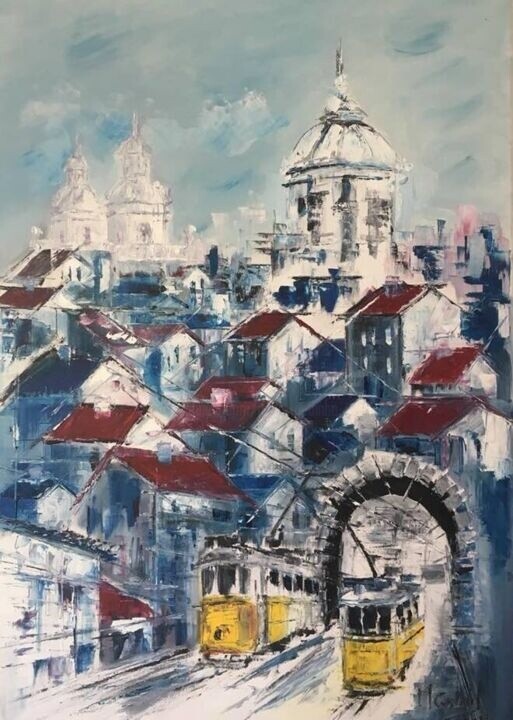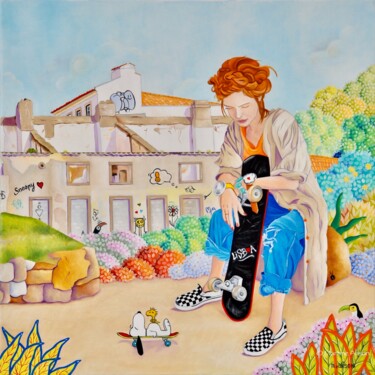 Inês Dourado, Bica Funicular, 2018. Watercolor on paper, 50 x 39 cm.
Inês Dourado, Bica Funicular, 2018. Watercolor on paper, 50 x 39 cm.
Brief history of the city of Lisbon
Lisbon, Portugal's most important and largest city, situated on seven hills at the mouth of the Tagus River and facing the Atlantic Ocean, has more than 500,000 inhabitants, as well as a history that can be traced back roughly as far as 300,000 years. In fact, the westernmost capital of continental Europe turns out to be one of the oldest cities in the world, so much so that its name is believed to have been derived from a popular legend, according to which the urbe was even founded by Ulysses, taking the name Ulyssesipo or Olissopo. Precisely in the famous epic poem of the Odyssey, Homer tells how Odysseus, before returning to his own Ithaca, probably arrived at the place where Lisbon now stands, where, enormously enthused by the natural beauty, he decided to build there what he intended should become the most beautiful city in the Universe. Unfortunately, however, the hero did not know that he had arrived in the kingdom of Ophiusa, "Land of Serpents" ruled by a despotic queen endowed with a beautiful woman's body, equipped with a reptilian tail. Nevertheless, the aforementioned situation failed to intimidate the leader, who, known for his cunning, managed to make the ruler fall hopelessly in love with him and be given his kingdom. In spite of this success, however, Odysseus thought better of resuming his journey home, so that he decided to flee, abandoning the woman. The latter, greatly gripped by grief, crawled so furiously in the direction of the river that her tail artfully shaped the present-day seven hills of the city of Lisbon. In fact, to this day, the seven hills of the Portuguese capital stretch out toward the Tagus, just as if they were searching for a distant lost love.
 Evelyne Deuil, Tramway of Lisbon. Oil painting, 100 x 80 cm.
Evelyne Deuil, Tramway of Lisbon. Oil painting, 100 x 80 cm.
 Corina Schröder, Lisbon, 2020. Oil on canvas, 120 x 100 cm.
Corina Schröder, Lisbon, 2020. Oil on canvas, 120 x 100 cm.
Continuing to delve deeper into the tale of the city's origins, in the earliest centuries it was populated by the Phoenicians, the Greeks, the Carthaginians, and finally the Romans, who gave rise to a long hegemony of more than two centuries. Precisely during the latter period, the Greek name Lisbon was replaced by the Latin name Olissipona, intended to indicate a city that was completely Romanized, both in architecture and customs. This sovereignty was succeeded by conquests at the hands of the migratory Alani peoples, who, later, were driven out by the Suebi, who in turn were conquered by the Visigoths. After these various governments, the Muslims of North Africa, also called Moors, took over the Iberian Peninsula in the 8th century, and consequently also the city of Lisbon, where they remained for about 400 years. This domination came to an end in the 12th century, that is, during the period of the Reconquista, a phase in which Christian armies did their utmost to retake the Moorish Muslim kingdoms in Spain and Portugal. It was in this context that, in 1147, the first king of Portugal Afonso Henriques succeeded, with the help of crusaders and after a siege that lasted several months, in recapturing Lisbon.
 Patricia Lejeune, Lisbon, 2021. Oil on linen canvas, 100 x 100 cm.
Patricia Lejeune, Lisbon, 2021. Oil on linen canvas, 100 x 100 cm.
 Maria Godinho, Lisbon of my charms, 2018. Oil on linen canvas, 100 x 70 cm.
Maria Godinho, Lisbon of my charms, 2018. Oil on linen canvas, 100 x 70 cm.
In 1508, however, the country came under Spanish rule, which lasted until, in 1640, the invaders were ousted at the hands of the Duke of Braganza, later crowned as king of Portugal with the name of Joao IV. This period, marked by great prosperity, came to a tragic end on November 1, 1755, when the city was devastated by one of the largest earthquakes ever recorded in the country. Despite the many difficulties related to the tragic event, thanks to the plans of the well-known Marquis of Pombal, Lisbon was quickly rebuilt, enriching itself with characteristic elements that distinguish the city even today, just like the iconic Baixa Pombalina, the historic heart and commercial center of the capital, the Pombalino-style buildings, and the numerous Avenidas Novas. Later, and more specifically during the years of Salazar's twentieth-century dictatorship, Portugal's capital was greatly modernized. After the peaceful coup d'état of 1974, which decreed the end of authoritarian rule, a period of severe economic crisis and political instability pervaded, during which Lisbon's municipality worked to thwart the green light for speculative building projects, which were deemed extremely dangerous to the environment of the city's historic areas. Finally, Portugal's integration into the European Economic Community, which took place in 1986, largely stimulated the further modernization of the said capital city, which began to enjoy multiple benefits drawn from investments by private individuals aimed at contributing to the construction of new buildings.
 Ivo Antunes, Estrela Basilica, 2019. Acrylic / pencil on canvas, 80 x 120 cm.
Ivo Antunes, Estrela Basilica, 2019. Acrylic / pencil on canvas, 80 x 120 cm.
 Jacques Villares, Lisbon II. Watercolor on paper, 26 x 36 cm.
Jacques Villares, Lisbon II. Watercolor on paper, 26 x 36 cm.
Lisbon in the works of the artists of Artmajeur
The most characteristic view of the Portuguese capital is surely the one that immortalizes its many alleyways traversed by the typical yellow streetcar, an iconic means of transportation that has unquestionably become one of the city's main symbols. Within this popular glimpse of the cityscape, one can also highlight the rich succession of Lisbon's perched houses, which, cooled by the ocean breeze, are capable of carrying with them the ancient stories of fishermen and sailors. In addition, it is impossible not to think of Lisbon's most famous sights, such as the Alfama neighborhood, the Baixa district, the Castle of São Jorge, the iconic Praça do Comércio, the Miradouro de Santa Luzia, the Cathedral, the Convento do Carmo, the Torre de Belém, and many other attractions, whose charm has also been immortalized by the personal and innovative viewpoints of Artmajeur's artists, who, just as well represented by the works of Inês Dourado, Thierry Van Quickenborne and Maria Godinho, are capable of serving as our "guide" to the city's beauty.
 Inês Dourado, National Pantheon, Lisbon, 2013. Watercolor on paper, 27 x 18 cm.
Inês Dourado, National Pantheon, Lisbon, 2013. Watercolor on paper, 27 x 18 cm.
Inês Dourado: National Pantheon, Lisbon
National Pantheon, Lisbon by Inês Dourado, a Portuguese painter born in 1958, depicts with all the delicacy and refinement of watercolor one of the most famous attractions of Portugal's capital, namely the church of Santa Engracia, whose dome strongly characterizes the city's skyline. Of the building originally founded in 1568, by order of the daughter of King Manuel I, Princess Maria, nothing remains, as the ancient church was destroyed in 1681. Fortunately, however, the year following the fateful event, work was begun by architect and master mason João Antunes on the construction of the new Baroque-style building on a Greek cross base. This church, completed in 1966, is distinguished by a solemn and sumptuous interior, intended to recall the magnificence of Roman buildings of the same style. Finally, in addition to the building's mighty dome, the colored marble floor and cenotaphs of heroes of Portuguese history such as, for example, Vasco da Gama, Afonso de Albuquerque and Henry the Navigator are also noteworthy. Therefore, Inês Dourado's watercolor turns out to be a city view enriched with considerable art-historical significance, capable of making us constantly know, visit, admire and appreciate, one of the most iconic symbols of the Portuguese capital.
 Maria Godinho, Black and white lisbon, 2022. Acrylic on canvas, 120 x 100 cm.
Maria Godinho, Black and white lisbon, 2022. Acrylic on canvas, 120 x 100 cm.
Maria Godinho: Black and white lisbon
The figurative tour of the beauties of the city of Lisbon continues through the enjoyment of the black-and-white painting by Portuguese artist Maria Godinho, which, precisely because of its chromatic and perspective peculiarities, allows us to isolate in space, and in time, the Arch of Rua Agusta, enabling its more accurate contemplation. Speaking of the latter triumphal architecture, it, placed at the beginning of Rua Augusta, represents the monumental entrance to the city, aimed at connecting the wide Commerce Square to the historic center. As for the history of the Arch, its design dates back to the eighteenth century, a period when the Marquis of Pombal did his utmost to initiate the rebirth of the city after the violent earthquake of 1755. Despite this looming desire for renewal, the construction of the Arch proved to be very long and troubled. In fact, The original design of architect Eugénio dos Santos was never completed due to his death in 1760. Therefore, only after a variety of vicissitudes did architect Veríssimo José da Costa complete the work in 1873, presenting a delay of no less than 113 years from their original schedule.
 Thierry Van Quickenborne, Lisboa all color, 2021. Digital print on aluminum, 50 x 100 cm.
Thierry Van Quickenborne, Lisboa all color, 2021. Digital print on aluminum, 50 x 100 cm.
Thierry Van Quickenborne: Lisboa all color
Highly representative of the essence of Lisbon's reality is the surreal and imaginative work by Thierry Van Quickenborne, who, in addition to immortalizing the iconic yellow streetcar, juxtaposes other unfailing symbols of the city in a single composition, such as: the April 25 Bridge, the Belém Tower and, in the distance, the Cristo-Rei statue. Despite such figurative richness, the subject that captures the viewer's attention first, both in terms of color and placement within the perspective space, is the yellow streetcar number 28. The latter means of transportation, which first came into operation around 1914 in order to replace horse-drawn carriages, is extremely well known as it runs through the city's most popular neighborhoods, namely: the Graca, Alfama, Baixa, Chiado, and Estrela Santa Catarina. In addition, as anticipated, the press also immortalizes: the April 25 Bridge, which, originally named the Salazar Bridge, changed its name following the restoration of democracy in Portugal; The Torre de Belém, which, built in the early 16th century in the Manueline style, was commissioned by King John II as part of a defense system at the mouth of the Tagus River; and the Cristo-Rei, a large statue of Jesus, which is located in the Pragal friguesia in the city of Almada, in the metropolitan area of Lisbon.


 Olimpia Gaia Martinelli
Olimpia Gaia Martinelli























